Qualitative and Quantitative Study on Workplace Support and Medical Errors
VerifiedAdded on 2023/01/19
|12
|2904
|69
AI Summary
This document discusses a qualitative and quantitative study on workplace support and its impact on reducing medical errors. It explores the aim, significance, research design, sampling technique, data collection method, and findings of the study. The study focuses on understanding the experiences and perspectives of nurses on preventing medical errors and highlights the importance of workplace support in reducing errors during practice. The findings suggest that relationships and support in the workplace play a crucial role in reducing medical errors.
Contribute Materials
Your contribution can guide someone’s learning journey. Share your
documents today.
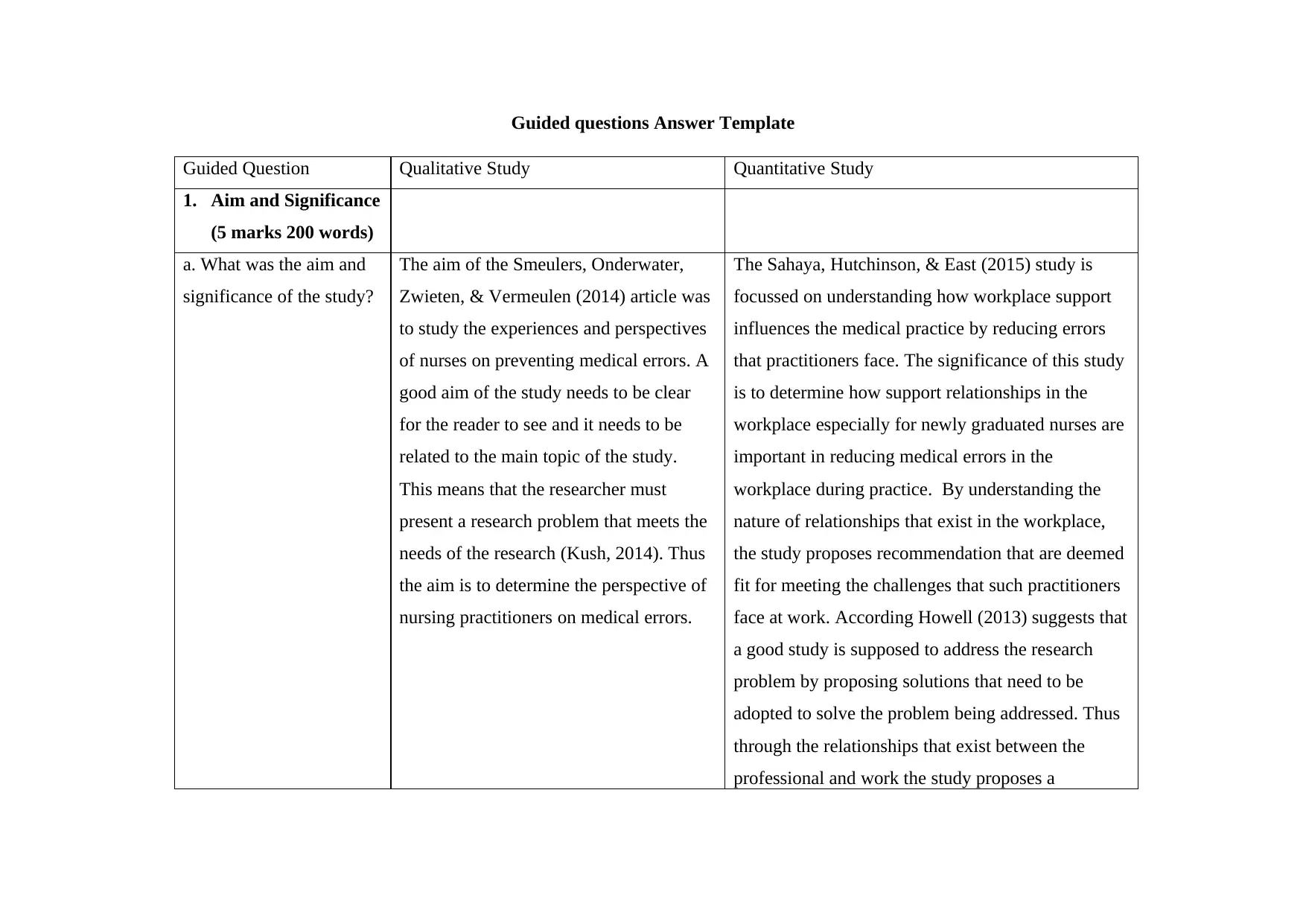
Guided questions Answer Template
Guided Question Qualitative Study Quantitative Study
1. Aim and Significance
(5 marks 200 words)
a. What was the aim and
significance of the study?
The aim of the Smeulers, Onderwater,
Zwieten, & Vermeulen (2014) article was
to study the experiences and perspectives
of nurses on preventing medical errors. A
good aim of the study needs to be clear
for the reader to see and it needs to be
related to the main topic of the study.
This means that the researcher must
present a research problem that meets the
needs of the research (Kush, 2014). Thus
the aim is to determine the perspective of
nursing practitioners on medical errors.
The Sahaya, Hutchinson, & East (2015) study is
focussed on understanding how workplace support
influences the medical practice by reducing errors
that practitioners face. The significance of this study
is to determine how support relationships in the
workplace especially for newly graduated nurses are
important in reducing medical errors in the
workplace during practice. By understanding the
nature of relationships that exist in the workplace,
the study proposes recommendation that are deemed
fit for meeting the challenges that such practitioners
face at work. According Howell (2013) suggests that
a good study is supposed to address the research
problem by proposing solutions that need to be
adopted to solve the problem being addressed. Thus
through the relationships that exist between the
professional and work the study proposes a
Guided Question Qualitative Study Quantitative Study
1. Aim and Significance
(5 marks 200 words)
a. What was the aim and
significance of the study?
The aim of the Smeulers, Onderwater,
Zwieten, & Vermeulen (2014) article was
to study the experiences and perspectives
of nurses on preventing medical errors. A
good aim of the study needs to be clear
for the reader to see and it needs to be
related to the main topic of the study.
This means that the researcher must
present a research problem that meets the
needs of the research (Kush, 2014). Thus
the aim is to determine the perspective of
nursing practitioners on medical errors.
The Sahaya, Hutchinson, & East (2015) study is
focussed on understanding how workplace support
influences the medical practice by reducing errors
that practitioners face. The significance of this study
is to determine how support relationships in the
workplace especially for newly graduated nurses are
important in reducing medical errors in the
workplace during practice. By understanding the
nature of relationships that exist in the workplace,
the study proposes recommendation that are deemed
fit for meeting the challenges that such practitioners
face at work. According Howell (2013) suggests that
a good study is supposed to address the research
problem by proposing solutions that need to be
adopted to solve the problem being addressed. Thus
through the relationships that exist between the
professional and work the study proposes a
Secure Best Marks with AI Grader
Need help grading? Try our AI Grader for instant feedback on your assignments.
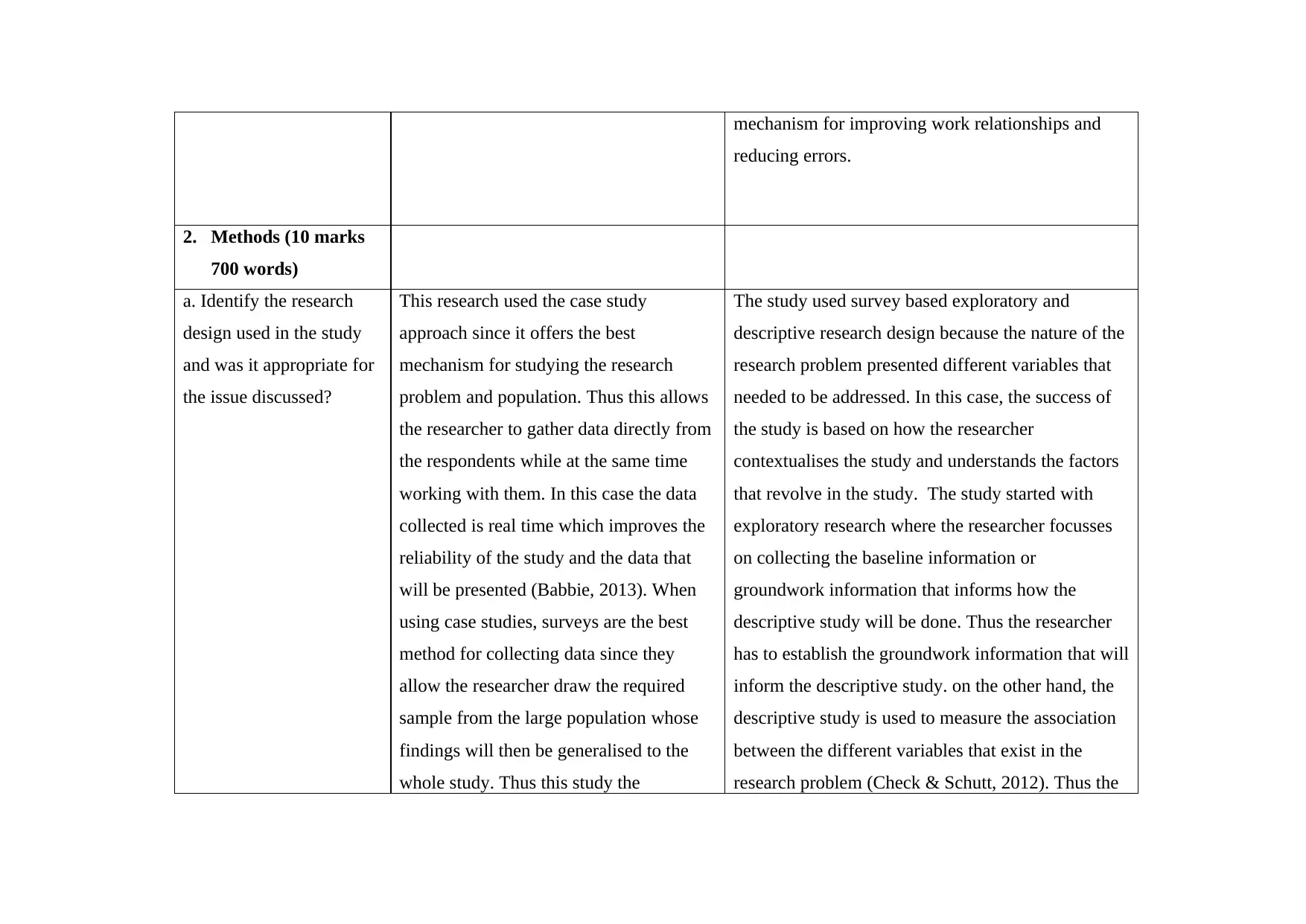
mechanism for improving work relationships and
reducing errors.
2. Methods (10 marks
700 words)
a. Identify the research
design used in the study
and was it appropriate for
the issue discussed?
This research used the case study
approach since it offers the best
mechanism for studying the research
problem and population. Thus this allows
the researcher to gather data directly from
the respondents while at the same time
working with them. In this case the data
collected is real time which improves the
reliability of the study and the data that
will be presented (Babbie, 2013). When
using case studies, surveys are the best
method for collecting data since they
allow the researcher draw the required
sample from the large population whose
findings will then be generalised to the
whole study. Thus this study the
The study used survey based exploratory and
descriptive research design because the nature of the
research problem presented different variables that
needed to be addressed. In this case, the success of
the study is based on how the researcher
contextualises the study and understands the factors
that revolve in the study. The study started with
exploratory research where the researcher focusses
on collecting the baseline information or
groundwork information that informs how the
descriptive study will be done. Thus the researcher
has to establish the groundwork information that will
inform the descriptive study. on the other hand, the
descriptive study is used to measure the association
between the different variables that exist in the
research problem (Check & Schutt, 2012). Thus the
reducing errors.
2. Methods (10 marks
700 words)
a. Identify the research
design used in the study
and was it appropriate for
the issue discussed?
This research used the case study
approach since it offers the best
mechanism for studying the research
problem and population. Thus this allows
the researcher to gather data directly from
the respondents while at the same time
working with them. In this case the data
collected is real time which improves the
reliability of the study and the data that
will be presented (Babbie, 2013). When
using case studies, surveys are the best
method for collecting data since they
allow the researcher draw the required
sample from the large population whose
findings will then be generalised to the
whole study. Thus this study the
The study used survey based exploratory and
descriptive research design because the nature of the
research problem presented different variables that
needed to be addressed. In this case, the success of
the study is based on how the researcher
contextualises the study and understands the factors
that revolve in the study. The study started with
exploratory research where the researcher focusses
on collecting the baseline information or
groundwork information that informs how the
descriptive study will be done. Thus the researcher
has to establish the groundwork information that will
inform the descriptive study. on the other hand, the
descriptive study is used to measure the association
between the different variables that exist in the
research problem (Check & Schutt, 2012). Thus the
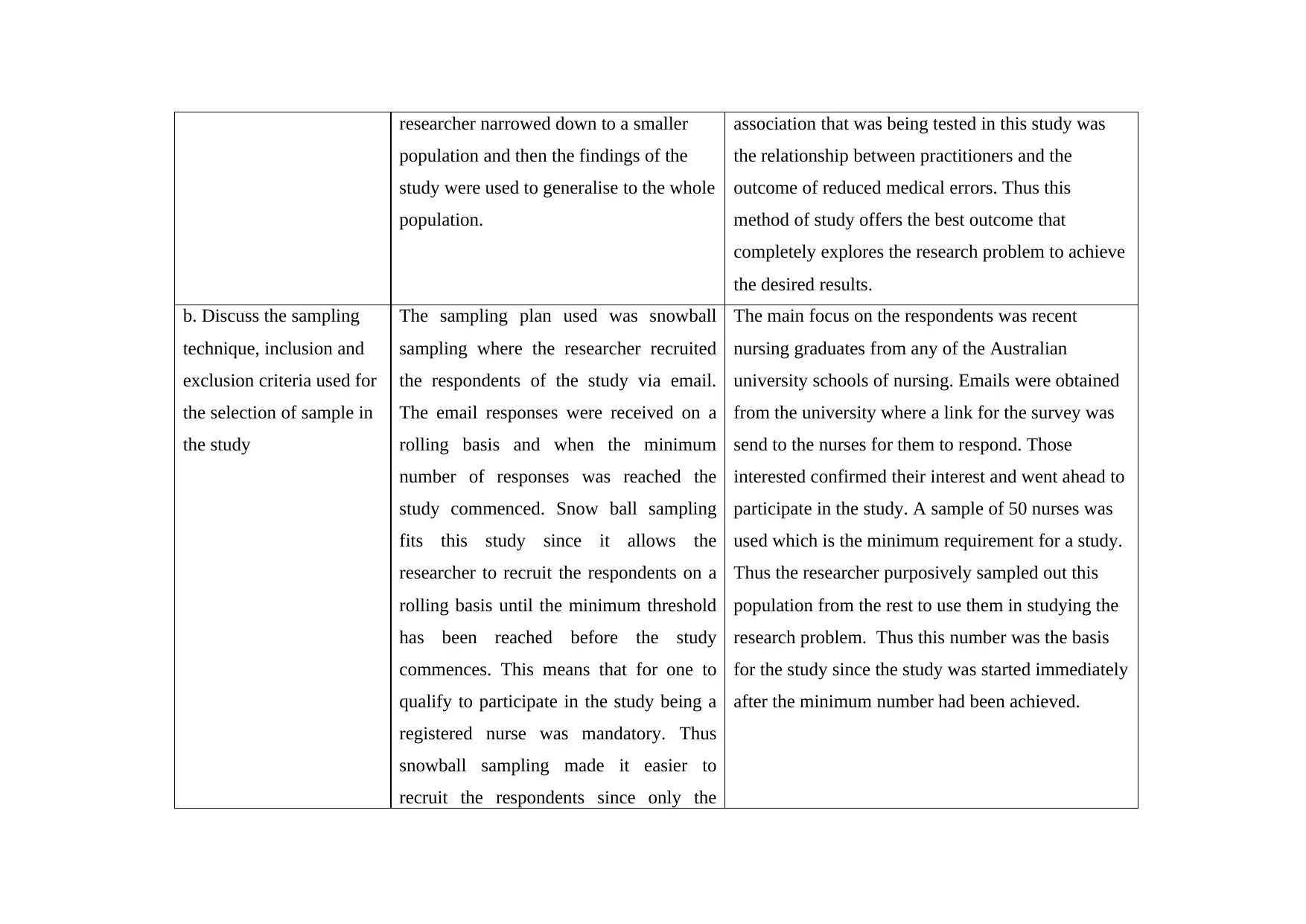
researcher narrowed down to a smaller
population and then the findings of the
study were used to generalise to the whole
population.
association that was being tested in this study was
the relationship between practitioners and the
outcome of reduced medical errors. Thus this
method of study offers the best outcome that
completely explores the research problem to achieve
the desired results.
b. Discuss the sampling
technique, inclusion and
exclusion criteria used for
the selection of sample in
the study
The sampling plan used was snowball
sampling where the researcher recruited
the respondents of the study via email.
The email responses were received on a
rolling basis and when the minimum
number of responses was reached the
study commenced. Snow ball sampling
fits this study since it allows the
researcher to recruit the respondents on a
rolling basis until the minimum threshold
has been reached before the study
commences. This means that for one to
qualify to participate in the study being a
registered nurse was mandatory. Thus
snowball sampling made it easier to
recruit the respondents since only the
The main focus on the respondents was recent
nursing graduates from any of the Australian
university schools of nursing. Emails were obtained
from the university where a link for the survey was
send to the nurses for them to respond. Those
interested confirmed their interest and went ahead to
participate in the study. A sample of 50 nurses was
used which is the minimum requirement for a study.
Thus the researcher purposively sampled out this
population from the rest to use them in studying the
research problem. Thus this number was the basis
for the study since the study was started immediately
after the minimum number had been achieved.
population and then the findings of the
study were used to generalise to the whole
population.
association that was being tested in this study was
the relationship between practitioners and the
outcome of reduced medical errors. Thus this
method of study offers the best outcome that
completely explores the research problem to achieve
the desired results.
b. Discuss the sampling
technique, inclusion and
exclusion criteria used for
the selection of sample in
the study
The sampling plan used was snowball
sampling where the researcher recruited
the respondents of the study via email.
The email responses were received on a
rolling basis and when the minimum
number of responses was reached the
study commenced. Snow ball sampling
fits this study since it allows the
researcher to recruit the respondents on a
rolling basis until the minimum threshold
has been reached before the study
commences. This means that for one to
qualify to participate in the study being a
registered nurse was mandatory. Thus
snowball sampling made it easier to
recruit the respondents since only the
The main focus on the respondents was recent
nursing graduates from any of the Australian
university schools of nursing. Emails were obtained
from the university where a link for the survey was
send to the nurses for them to respond. Those
interested confirmed their interest and went ahead to
participate in the study. A sample of 50 nurses was
used which is the minimum requirement for a study.
Thus the researcher purposively sampled out this
population from the rest to use them in studying the
research problem. Thus this number was the basis
for the study since the study was started immediately
after the minimum number had been achieved.
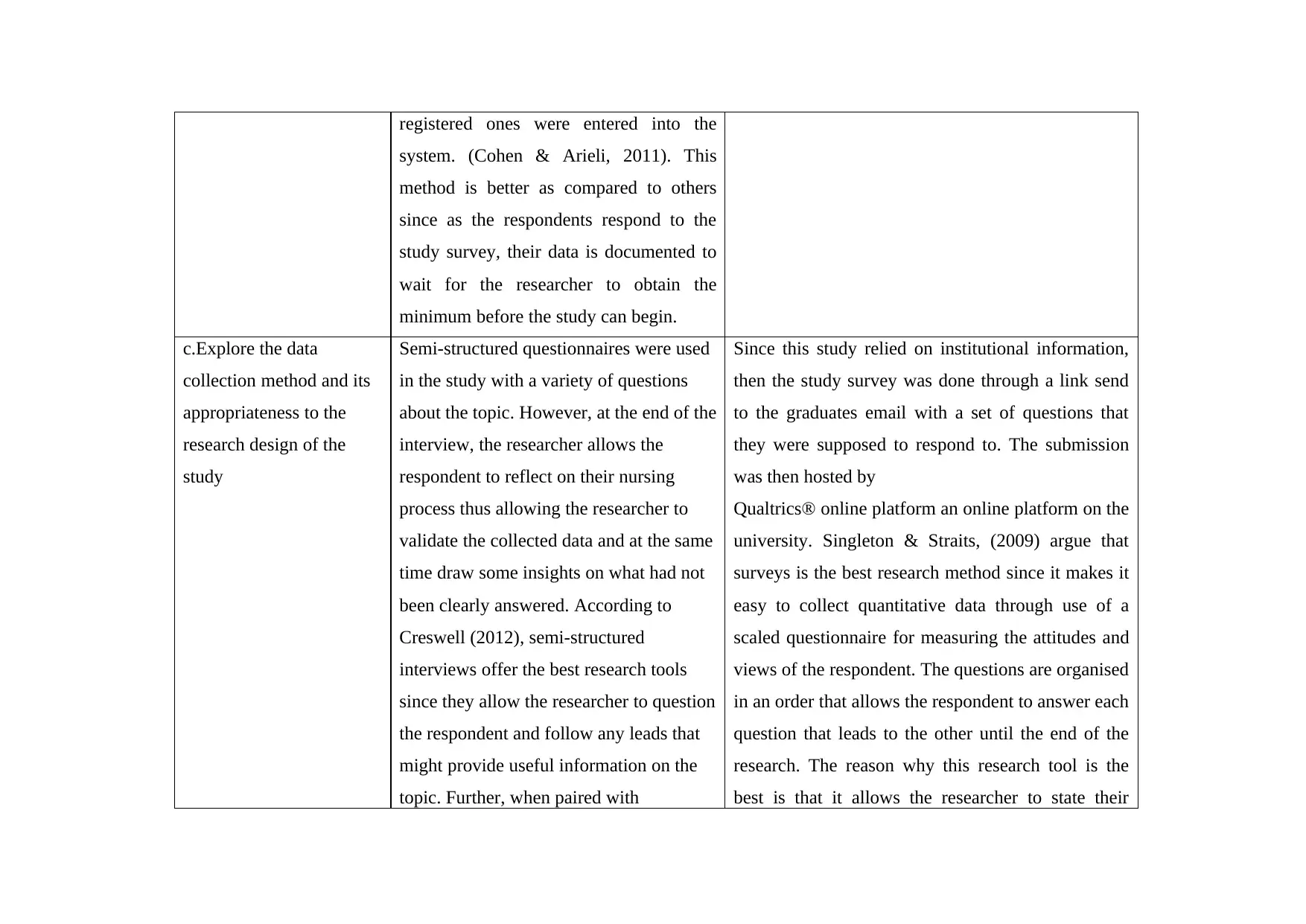
registered ones were entered into the
system. (Cohen & Arieli, 2011). This
method is better as compared to others
since as the respondents respond to the
study survey, their data is documented to
wait for the researcher to obtain the
minimum before the study can begin.
c.Explore the data
collection method and its
appropriateness to the
research design of the
study
Semi-structured questionnaires were used
in the study with a variety of questions
about the topic. However, at the end of the
interview, the researcher allows the
respondent to reflect on their nursing
process thus allowing the researcher to
validate the collected data and at the same
time draw some insights on what had not
been clearly answered. According to
Creswell (2012), semi-structured
interviews offer the best research tools
since they allow the researcher to question
the respondent and follow any leads that
might provide useful information on the
topic. Further, when paired with
Since this study relied on institutional information,
then the study survey was done through a link send
to the graduates email with a set of questions that
they were supposed to respond to. The submission
was then hosted by
Qualtrics® online platform an online platform on the
university. Singleton & Straits, (2009) argue that
surveys is the best research method since it makes it
easy to collect quantitative data through use of a
scaled questionnaire for measuring the attitudes and
views of the respondent. The questions are organised
in an order that allows the respondent to answer each
question that leads to the other until the end of the
research. The reason why this research tool is the
best is that it allows the researcher to state their
system. (Cohen & Arieli, 2011). This
method is better as compared to others
since as the respondents respond to the
study survey, their data is documented to
wait for the researcher to obtain the
minimum before the study can begin.
c.Explore the data
collection method and its
appropriateness to the
research design of the
study
Semi-structured questionnaires were used
in the study with a variety of questions
about the topic. However, at the end of the
interview, the researcher allows the
respondent to reflect on their nursing
process thus allowing the researcher to
validate the collected data and at the same
time draw some insights on what had not
been clearly answered. According to
Creswell (2012), semi-structured
interviews offer the best research tools
since they allow the researcher to question
the respondent and follow any leads that
might provide useful information on the
topic. Further, when paired with
Since this study relied on institutional information,
then the study survey was done through a link send
to the graduates email with a set of questions that
they were supposed to respond to. The submission
was then hosted by
Qualtrics® online platform an online platform on the
university. Singleton & Straits, (2009) argue that
surveys is the best research method since it makes it
easy to collect quantitative data through use of a
scaled questionnaire for measuring the attitudes and
views of the respondent. The questions are organised
in an order that allows the respondent to answer each
question that leads to the other until the end of the
research. The reason why this research tool is the
best is that it allows the researcher to state their
Secure Best Marks with AI Grader
Need help grading? Try our AI Grader for instant feedback on your assignments.
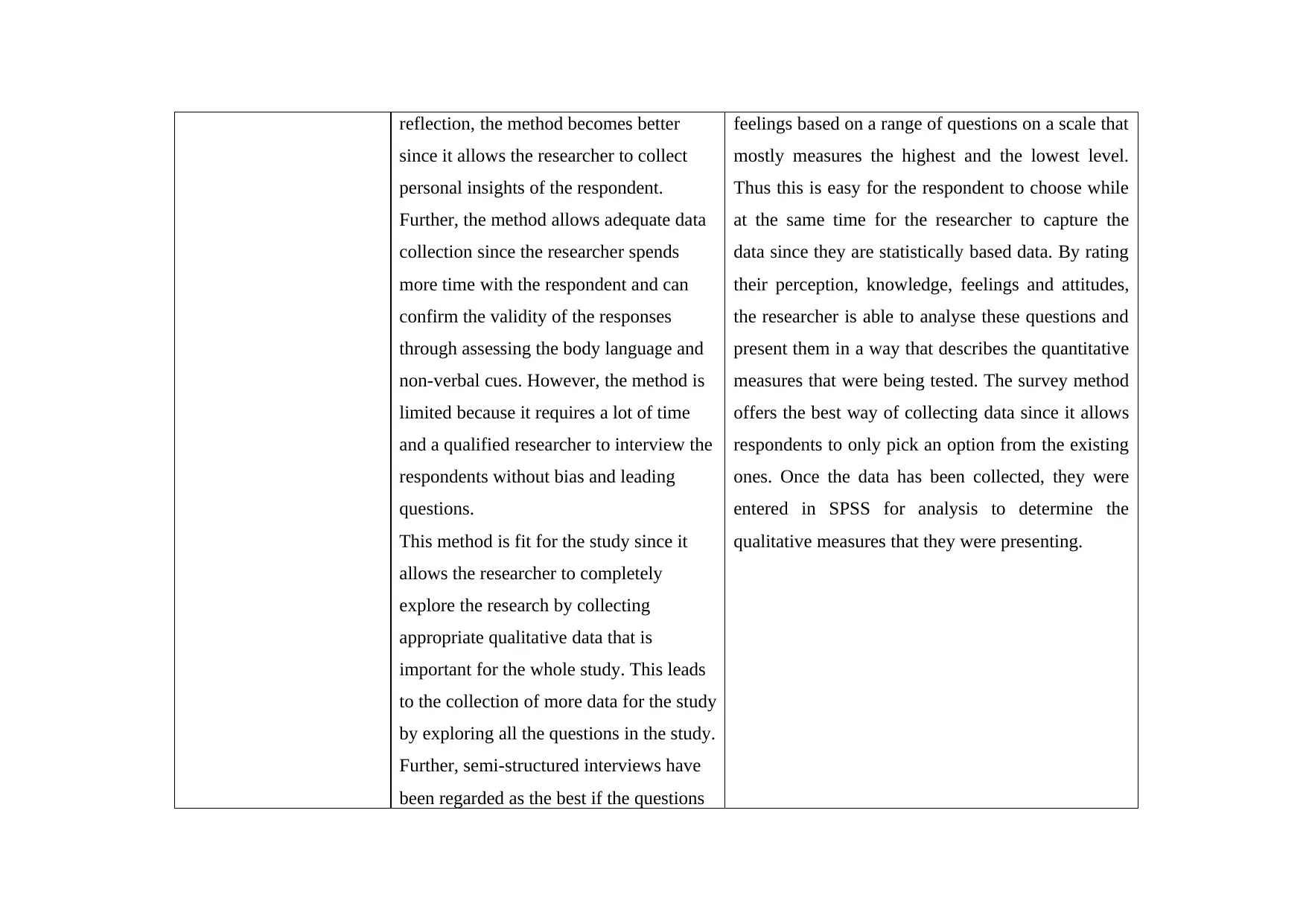
reflection, the method becomes better
since it allows the researcher to collect
personal insights of the respondent.
Further, the method allows adequate data
collection since the researcher spends
more time with the respondent and can
confirm the validity of the responses
through assessing the body language and
non-verbal cues. However, the method is
limited because it requires a lot of time
and a qualified researcher to interview the
respondents without bias and leading
questions.
This method is fit for the study since it
allows the researcher to completely
explore the research by collecting
appropriate qualitative data that is
important for the whole study. This leads
to the collection of more data for the study
by exploring all the questions in the study.
Further, semi-structured interviews have
been regarded as the best if the questions
feelings based on a range of questions on a scale that
mostly measures the highest and the lowest level.
Thus this is easy for the respondent to choose while
at the same time for the researcher to capture the
data since they are statistically based data. By rating
their perception, knowledge, feelings and attitudes,
the researcher is able to analyse these questions and
present them in a way that describes the quantitative
measures that were being tested. The survey method
offers the best way of collecting data since it allows
respondents to only pick an option from the existing
ones. Once the data has been collected, they were
entered in SPSS for analysis to determine the
qualitative measures that they were presenting.
since it allows the researcher to collect
personal insights of the respondent.
Further, the method allows adequate data
collection since the researcher spends
more time with the respondent and can
confirm the validity of the responses
through assessing the body language and
non-verbal cues. However, the method is
limited because it requires a lot of time
and a qualified researcher to interview the
respondents without bias and leading
questions.
This method is fit for the study since it
allows the researcher to completely
explore the research by collecting
appropriate qualitative data that is
important for the whole study. This leads
to the collection of more data for the study
by exploring all the questions in the study.
Further, semi-structured interviews have
been regarded as the best if the questions
feelings based on a range of questions on a scale that
mostly measures the highest and the lowest level.
Thus this is easy for the respondent to choose while
at the same time for the researcher to capture the
data since they are statistically based data. By rating
their perception, knowledge, feelings and attitudes,
the researcher is able to analyse these questions and
present them in a way that describes the quantitative
measures that were being tested. The survey method
offers the best way of collecting data since it allows
respondents to only pick an option from the existing
ones. Once the data has been collected, they were
entered in SPSS for analysis to determine the
qualitative measures that they were presenting.
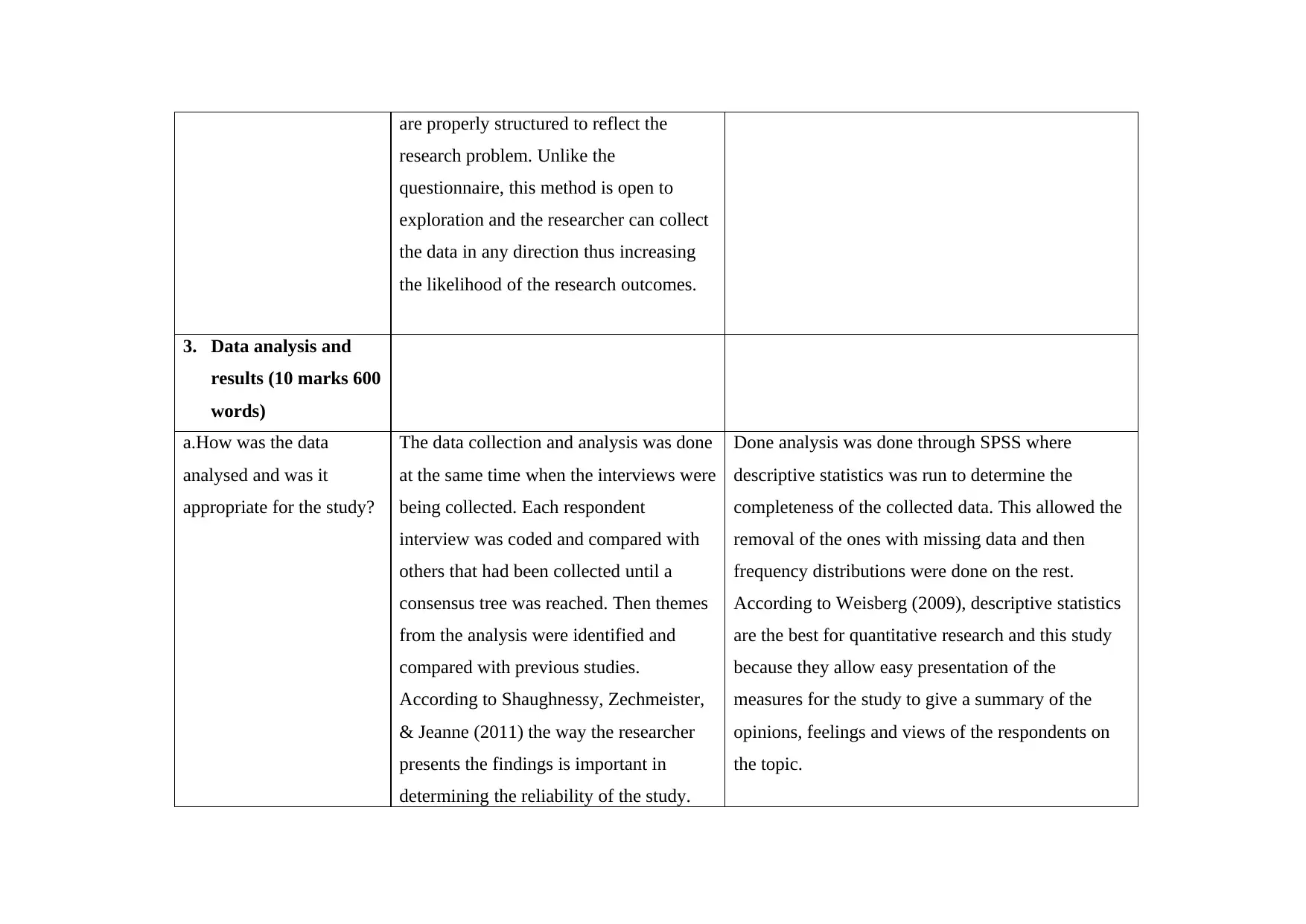
are properly structured to reflect the
research problem. Unlike the
questionnaire, this method is open to
exploration and the researcher can collect
the data in any direction thus increasing
the likelihood of the research outcomes.
3. Data analysis and
results (10 marks 600
words)
a.How was the data
analysed and was it
appropriate for the study?
The data collection and analysis was done
at the same time when the interviews were
being collected. Each respondent
interview was coded and compared with
others that had been collected until a
consensus tree was reached. Then themes
from the analysis were identified and
compared with previous studies.
According to Shaughnessy, Zechmeister,
& Jeanne (2011) the way the researcher
presents the findings is important in
determining the reliability of the study.
Done analysis was done through SPSS where
descriptive statistics was run to determine the
completeness of the collected data. This allowed the
removal of the ones with missing data and then
frequency distributions were done on the rest.
According to Weisberg (2009), descriptive statistics
are the best for quantitative research and this study
because they allow easy presentation of the
measures for the study to give a summary of the
opinions, feelings and views of the respondents on
the topic.
research problem. Unlike the
questionnaire, this method is open to
exploration and the researcher can collect
the data in any direction thus increasing
the likelihood of the research outcomes.
3. Data analysis and
results (10 marks 600
words)
a.How was the data
analysed and was it
appropriate for the study?
The data collection and analysis was done
at the same time when the interviews were
being collected. Each respondent
interview was coded and compared with
others that had been collected until a
consensus tree was reached. Then themes
from the analysis were identified and
compared with previous studies.
According to Shaughnessy, Zechmeister,
& Jeanne (2011) the way the researcher
presents the findings is important in
determining the reliability of the study.
Done analysis was done through SPSS where
descriptive statistics was run to determine the
completeness of the collected data. This allowed the
removal of the ones with missing data and then
frequency distributions were done on the rest.
According to Weisberg (2009), descriptive statistics
are the best for quantitative research and this study
because they allow easy presentation of the
measures for the study to give a summary of the
opinions, feelings and views of the respondents on
the topic.
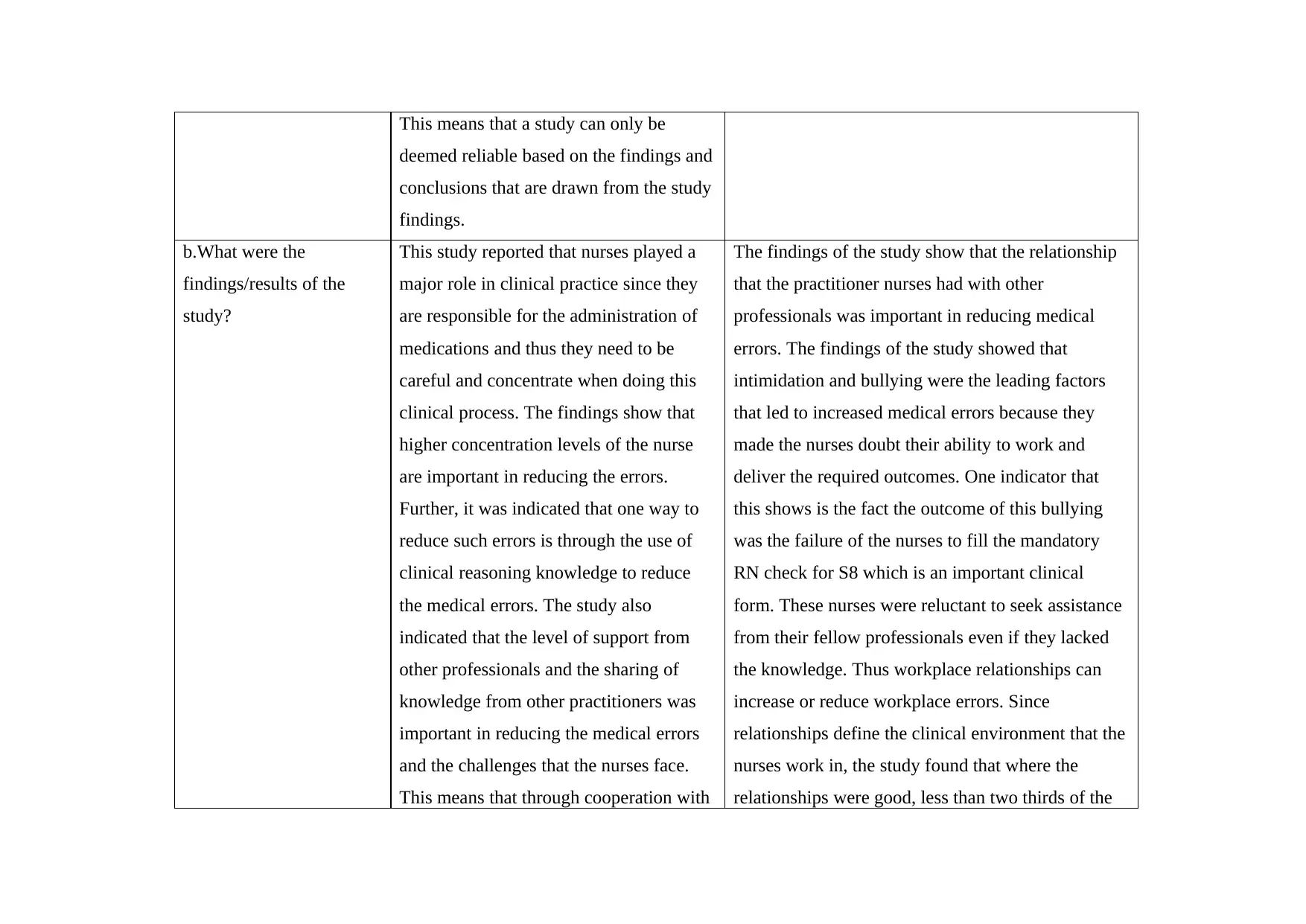
This means that a study can only be
deemed reliable based on the findings and
conclusions that are drawn from the study
findings.
b.What were the
findings/results of the
study?
This study reported that nurses played a
major role in clinical practice since they
are responsible for the administration of
medications and thus they need to be
careful and concentrate when doing this
clinical process. The findings show that
higher concentration levels of the nurse
are important in reducing the errors.
Further, it was indicated that one way to
reduce such errors is through the use of
clinical reasoning knowledge to reduce
the medical errors. The study also
indicated that the level of support from
other professionals and the sharing of
knowledge from other practitioners was
important in reducing the medical errors
and the challenges that the nurses face.
This means that through cooperation with
The findings of the study show that the relationship
that the practitioner nurses had with other
professionals was important in reducing medical
errors. The findings of the study showed that
intimidation and bullying were the leading factors
that led to increased medical errors because they
made the nurses doubt their ability to work and
deliver the required outcomes. One indicator that
this shows is the fact the outcome of this bullying
was the failure of the nurses to fill the mandatory
RN check for S8 which is an important clinical
form. These nurses were reluctant to seek assistance
from their fellow professionals even if they lacked
the knowledge. Thus workplace relationships can
increase or reduce workplace errors. Since
relationships define the clinical environment that the
nurses work in, the study found that where the
relationships were good, less than two thirds of the
deemed reliable based on the findings and
conclusions that are drawn from the study
findings.
b.What were the
findings/results of the
study?
This study reported that nurses played a
major role in clinical practice since they
are responsible for the administration of
medications and thus they need to be
careful and concentrate when doing this
clinical process. The findings show that
higher concentration levels of the nurse
are important in reducing the errors.
Further, it was indicated that one way to
reduce such errors is through the use of
clinical reasoning knowledge to reduce
the medical errors. The study also
indicated that the level of support from
other professionals and the sharing of
knowledge from other practitioners was
important in reducing the medical errors
and the challenges that the nurses face.
This means that through cooperation with
The findings of the study show that the relationship
that the practitioner nurses had with other
professionals was important in reducing medical
errors. The findings of the study showed that
intimidation and bullying were the leading factors
that led to increased medical errors because they
made the nurses doubt their ability to work and
deliver the required outcomes. One indicator that
this shows is the fact the outcome of this bullying
was the failure of the nurses to fill the mandatory
RN check for S8 which is an important clinical
form. These nurses were reluctant to seek assistance
from their fellow professionals even if they lacked
the knowledge. Thus workplace relationships can
increase or reduce workplace errors. Since
relationships define the clinical environment that the
nurses work in, the study found that where the
relationships were good, less than two thirds of the
Paraphrase This Document
Need a fresh take? Get an instant paraphrase of this document with our AI Paraphraser
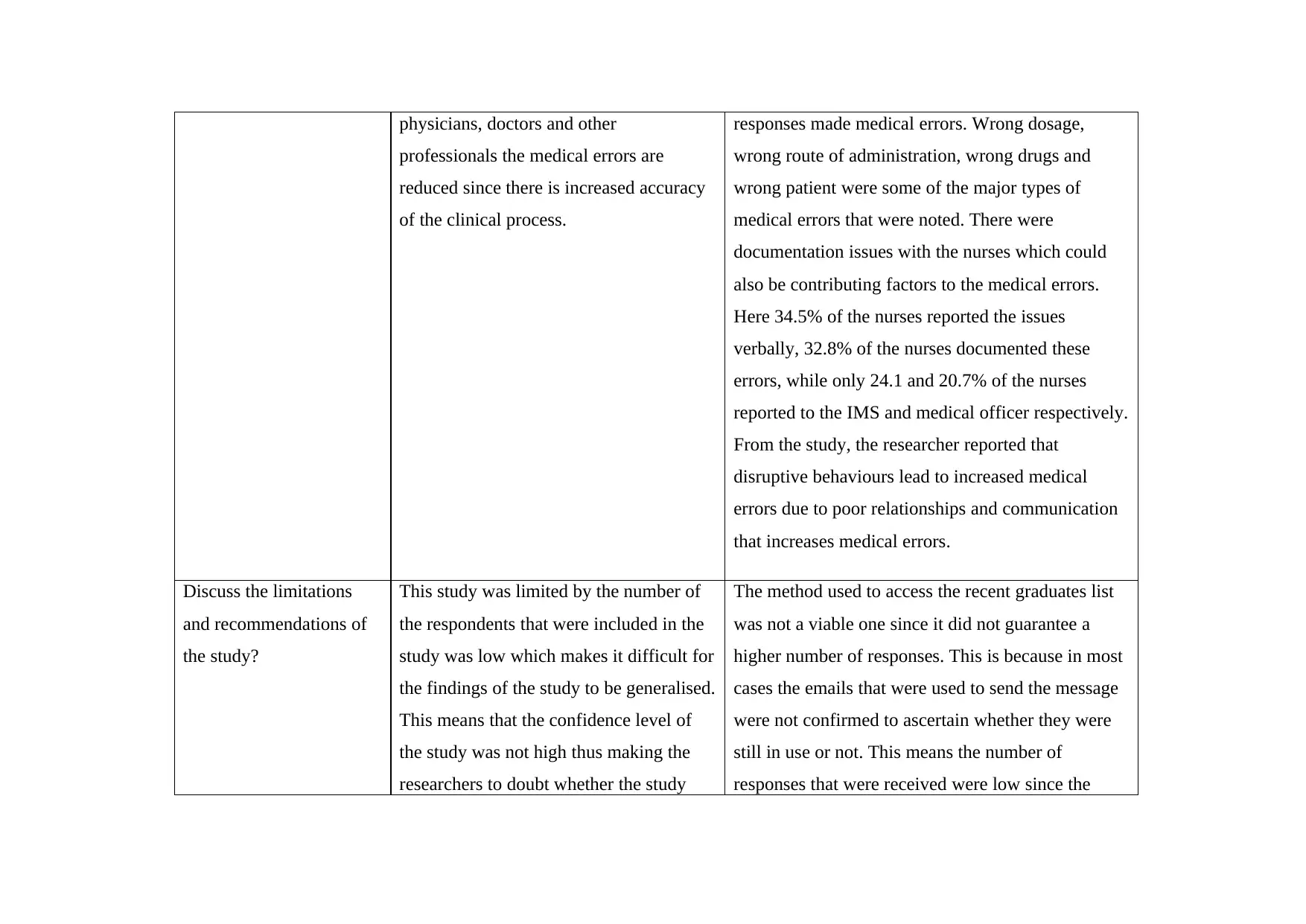
physicians, doctors and other
professionals the medical errors are
reduced since there is increased accuracy
of the clinical process.
responses made medical errors. Wrong dosage,
wrong route of administration, wrong drugs and
wrong patient were some of the major types of
medical errors that were noted. There were
documentation issues with the nurses which could
also be contributing factors to the medical errors.
Here 34.5% of the nurses reported the issues
verbally, 32.8% of the nurses documented these
errors, while only 24.1 and 20.7% of the nurses
reported to the IMS and medical officer respectively.
From the study, the researcher reported that
disruptive behaviours lead to increased medical
errors due to poor relationships and communication
that increases medical errors.
Discuss the limitations
and recommendations of
the study?
This study was limited by the number of
the respondents that were included in the
study was low which makes it difficult for
the findings of the study to be generalised.
This means that the confidence level of
the study was not high thus making the
researchers to doubt whether the study
The method used to access the recent graduates list
was not a viable one since it did not guarantee a
higher number of responses. This is because in most
cases the emails that were used to send the message
were not confirmed to ascertain whether they were
still in use or not. This means the number of
responses that were received were low since the
professionals the medical errors are
reduced since there is increased accuracy
of the clinical process.
responses made medical errors. Wrong dosage,
wrong route of administration, wrong drugs and
wrong patient were some of the major types of
medical errors that were noted. There were
documentation issues with the nurses which could
also be contributing factors to the medical errors.
Here 34.5% of the nurses reported the issues
verbally, 32.8% of the nurses documented these
errors, while only 24.1 and 20.7% of the nurses
reported to the IMS and medical officer respectively.
From the study, the researcher reported that
disruptive behaviours lead to increased medical
errors due to poor relationships and communication
that increases medical errors.
Discuss the limitations
and recommendations of
the study?
This study was limited by the number of
the respondents that were included in the
study was low which makes it difficult for
the findings of the study to be generalised.
This means that the confidence level of
the study was not high thus making the
researchers to doubt whether the study
The method used to access the recent graduates list
was not a viable one since it did not guarantee a
higher number of responses. This is because in most
cases the emails that were used to send the message
were not confirmed to ascertain whether they were
still in use or not. This means the number of
responses that were received were low since the
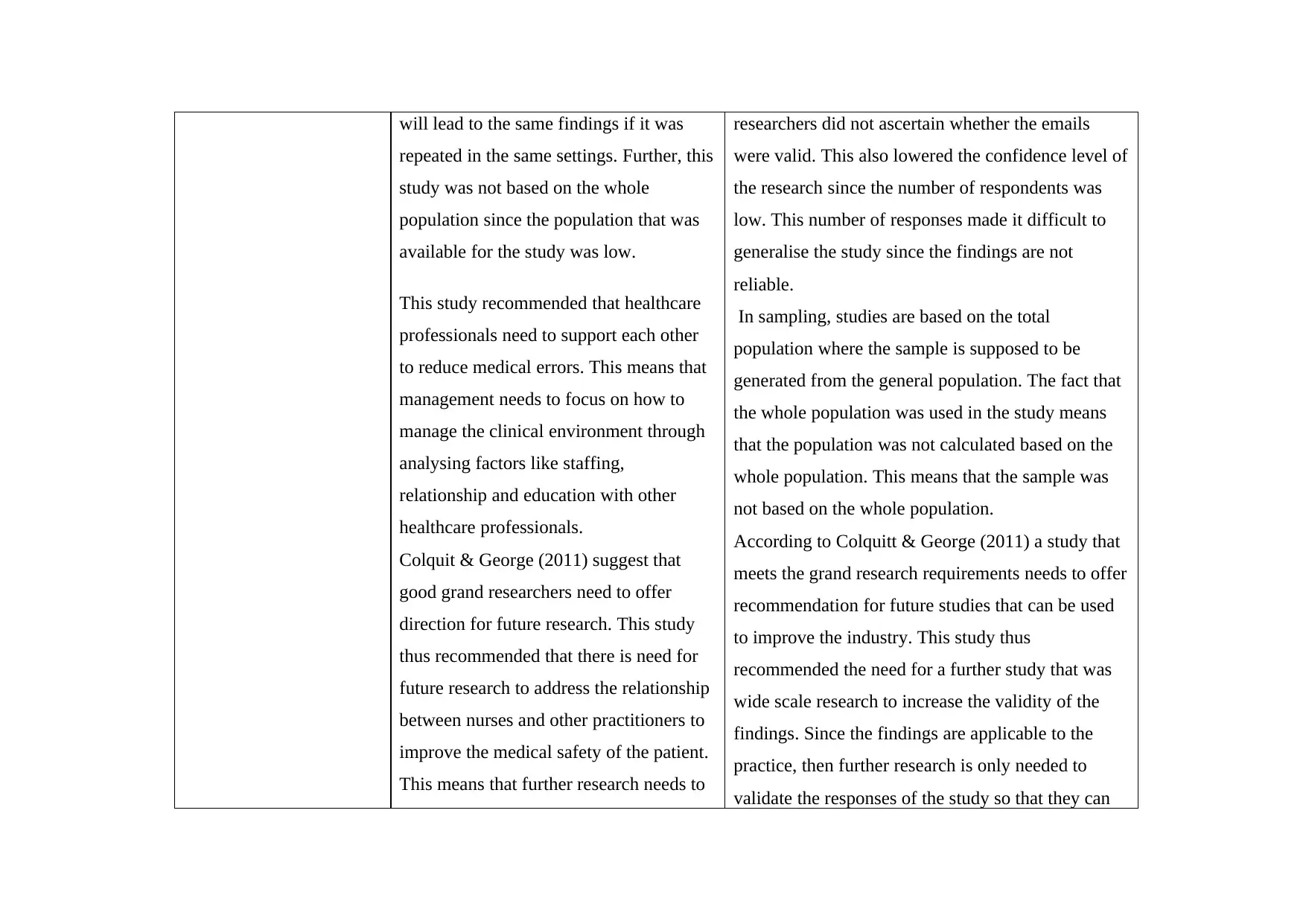
will lead to the same findings if it was
repeated in the same settings. Further, this
study was not based on the whole
population since the population that was
available for the study was low.
This study recommended that healthcare
professionals need to support each other
to reduce medical errors. This means that
management needs to focus on how to
manage the clinical environment through
analysing factors like staffing,
relationship and education with other
healthcare professionals.
Colquit & George (2011) suggest that
good grand researchers need to offer
direction for future research. This study
thus recommended that there is need for
future research to address the relationship
between nurses and other practitioners to
improve the medical safety of the patient.
This means that further research needs to
researchers did not ascertain whether the emails
were valid. This also lowered the confidence level of
the research since the number of respondents was
low. This number of responses made it difficult to
generalise the study since the findings are not
reliable.
In sampling, studies are based on the total
population where the sample is supposed to be
generated from the general population. The fact that
the whole population was used in the study means
that the population was not calculated based on the
whole population. This means that the sample was
not based on the whole population.
According to Colquitt & George (2011) a study that
meets the grand research requirements needs to offer
recommendation for future studies that can be used
to improve the industry. This study thus
recommended the need for a further study that was
wide scale research to increase the validity of the
findings. Since the findings are applicable to the
practice, then further research is only needed to
validate the responses of the study so that they can
repeated in the same settings. Further, this
study was not based on the whole
population since the population that was
available for the study was low.
This study recommended that healthcare
professionals need to support each other
to reduce medical errors. This means that
management needs to focus on how to
manage the clinical environment through
analysing factors like staffing,
relationship and education with other
healthcare professionals.
Colquit & George (2011) suggest that
good grand researchers need to offer
direction for future research. This study
thus recommended that there is need for
future research to address the relationship
between nurses and other practitioners to
improve the medical safety of the patient.
This means that further research needs to
researchers did not ascertain whether the emails
were valid. This also lowered the confidence level of
the research since the number of respondents was
low. This number of responses made it difficult to
generalise the study since the findings are not
reliable.
In sampling, studies are based on the total
population where the sample is supposed to be
generated from the general population. The fact that
the whole population was used in the study means
that the population was not calculated based on the
whole population. This means that the sample was
not based on the whole population.
According to Colquitt & George (2011) a study that
meets the grand research requirements needs to offer
recommendation for future studies that can be used
to improve the industry. This study thus
recommended the need for a further study that was
wide scale research to increase the validity of the
findings. Since the findings are applicable to the
practice, then further research is only needed to
validate the responses of the study so that they can
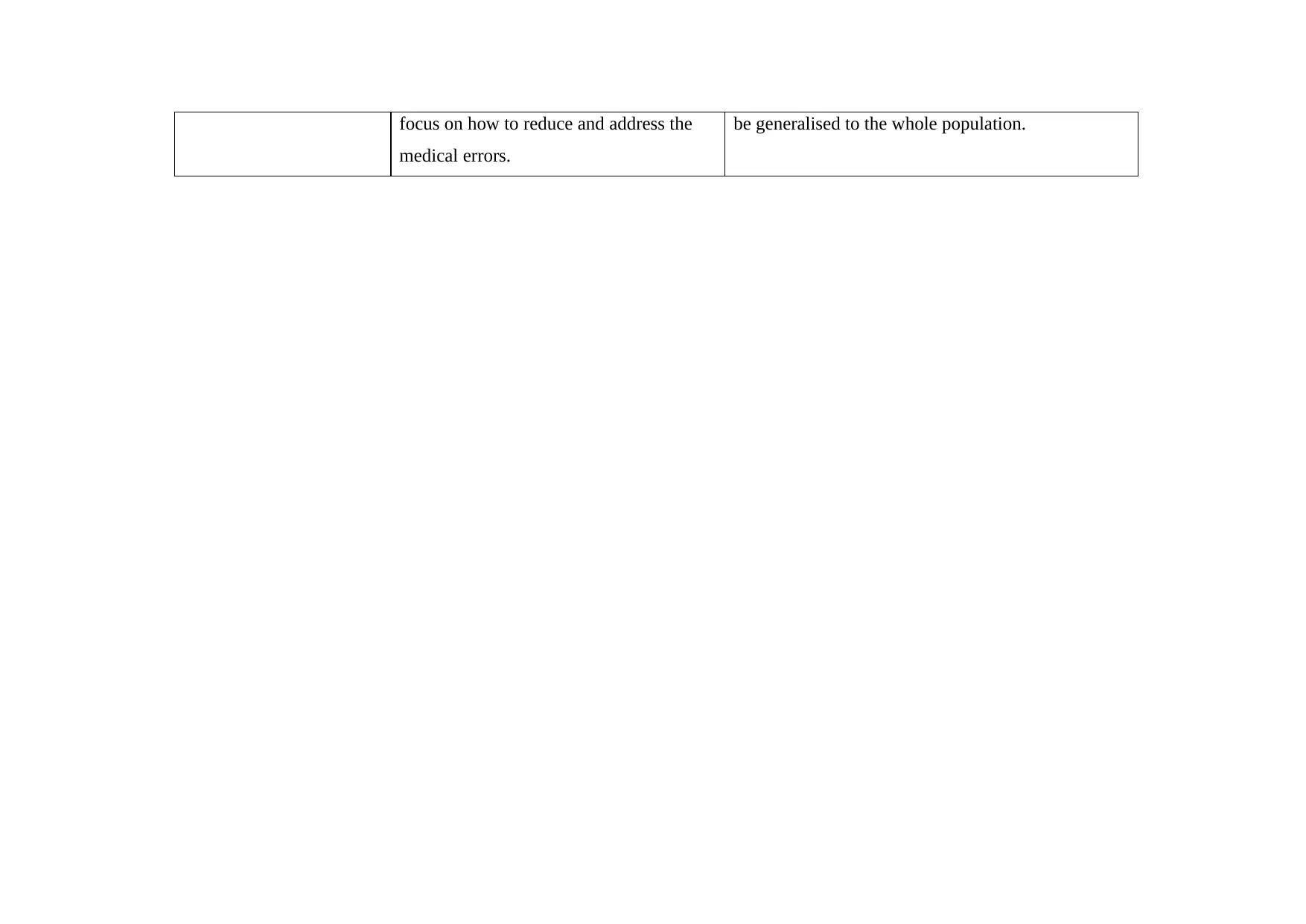
focus on how to reduce and address the
medical errors.
be generalised to the whole population.
medical errors.
be generalised to the whole population.
Secure Best Marks with AI Grader
Need help grading? Try our AI Grader for instant feedback on your assignments.
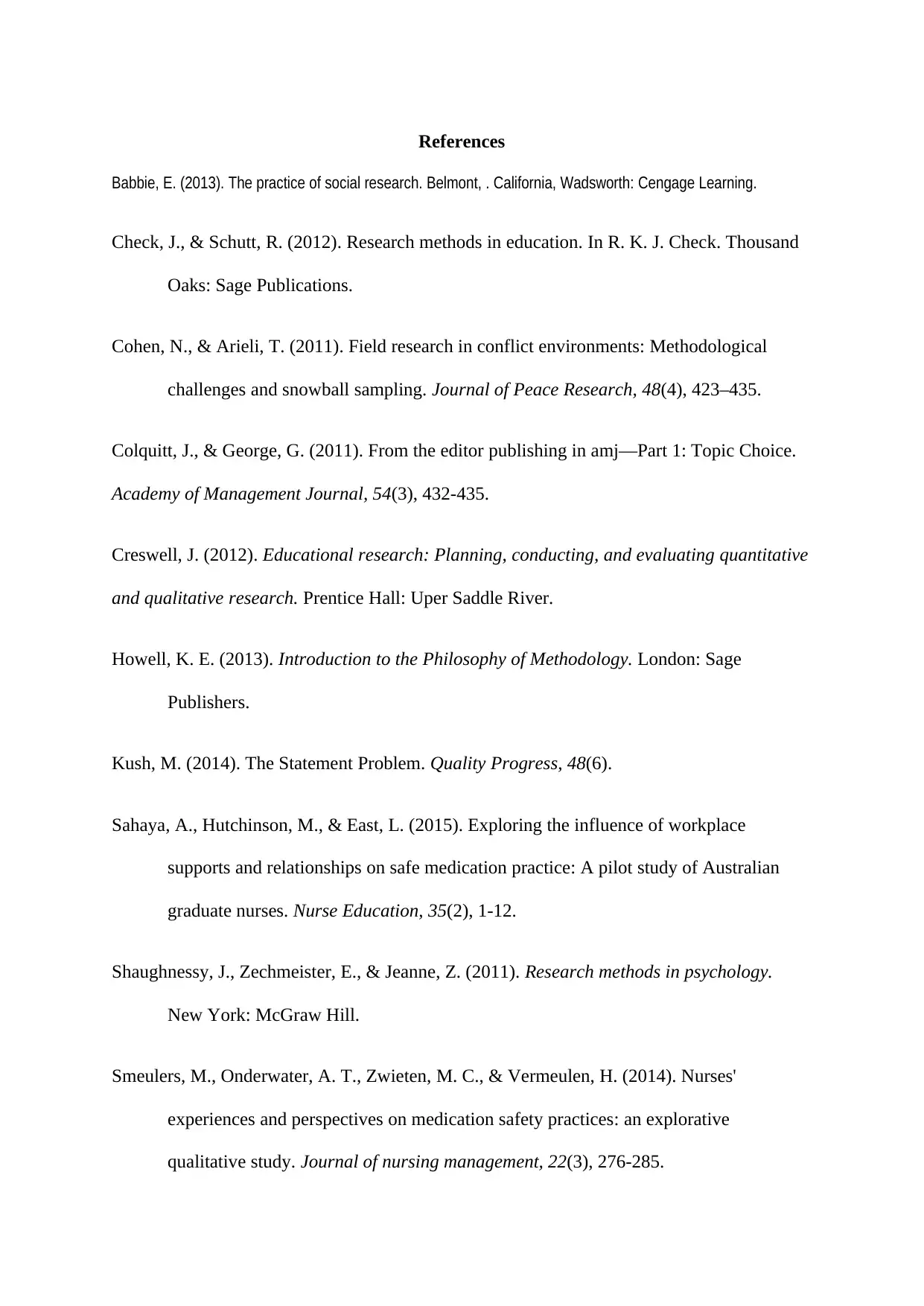
References
Babbie, E. (2013). The practice of social research. Belmont, . California, Wadsworth: Cengage Learning.
Check, J., & Schutt, R. (2012). Research methods in education. In R. K. J. Check. Thousand
Oaks: Sage Publications.
Cohen, N., & Arieli, T. (2011). Field research in conflict environments: Methodological
challenges and snowball sampling. Journal of Peace Research, 48(4), 423–435.
Colquitt, J., & George, G. (2011). From the editor publishing in amj—Part 1: Topic Choice.
Academy of Management Journal, 54(3), 432-435.
Creswell, J. (2012). Educational research: Planning, conducting, and evaluating quantitative
and qualitative research. Prentice Hall: Uper Saddle River.
Howell, K. E. (2013). Introduction to the Philosophy of Methodology. London: Sage
Publishers.
Kush, M. (2014). The Statement Problem. Quality Progress, 48(6).
Sahaya, A., Hutchinson, M., & East, L. (2015). Exploring the influence of workplace
supports and relationships on safe medication practice: A pilot study of Australian
graduate nurses. Nurse Education, 35(2), 1-12.
Shaughnessy, J., Zechmeister, E., & Jeanne, Z. (2011). Research methods in psychology.
New York: McGraw Hill.
Smeulers, M., Onderwater, A. T., Zwieten, M. C., & Vermeulen, H. (2014). Nurses'
experiences and perspectives on medication safety practices: an explorative
qualitative study. Journal of nursing management, 22(3), 276-285.
Babbie, E. (2013). The practice of social research. Belmont, . California, Wadsworth: Cengage Learning.
Check, J., & Schutt, R. (2012). Research methods in education. In R. K. J. Check. Thousand
Oaks: Sage Publications.
Cohen, N., & Arieli, T. (2011). Field research in conflict environments: Methodological
challenges and snowball sampling. Journal of Peace Research, 48(4), 423–435.
Colquitt, J., & George, G. (2011). From the editor publishing in amj—Part 1: Topic Choice.
Academy of Management Journal, 54(3), 432-435.
Creswell, J. (2012). Educational research: Planning, conducting, and evaluating quantitative
and qualitative research. Prentice Hall: Uper Saddle River.
Howell, K. E. (2013). Introduction to the Philosophy of Methodology. London: Sage
Publishers.
Kush, M. (2014). The Statement Problem. Quality Progress, 48(6).
Sahaya, A., Hutchinson, M., & East, L. (2015). Exploring the influence of workplace
supports and relationships on safe medication practice: A pilot study of Australian
graduate nurses. Nurse Education, 35(2), 1-12.
Shaughnessy, J., Zechmeister, E., & Jeanne, Z. (2011). Research methods in psychology.
New York: McGraw Hill.
Smeulers, M., Onderwater, A. T., Zwieten, M. C., & Vermeulen, H. (2014). Nurses'
experiences and perspectives on medication safety practices: an explorative
qualitative study. Journal of nursing management, 22(3), 276-285.
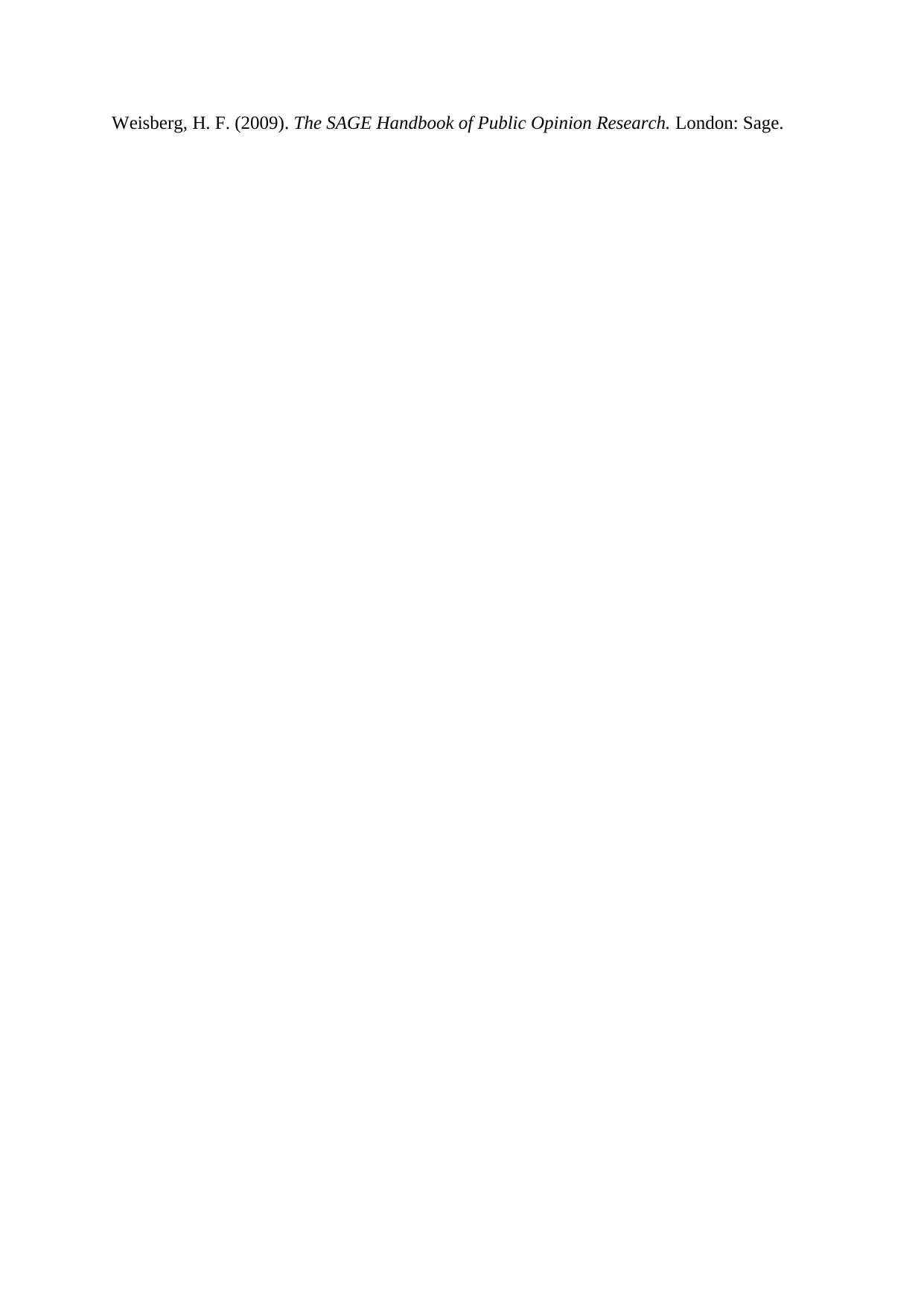
Weisberg, H. F. (2009). The SAGE Handbook of Public Opinion Research. London: Sage.
1 out of 12
Related Documents
Your All-in-One AI-Powered Toolkit for Academic Success.
+13062052269
info@desklib.com
Available 24*7 on WhatsApp / Email
![[object Object]](/_next/static/media/star-bottom.7253800d.svg)
Unlock your academic potential
© 2024 | Zucol Services PVT LTD | All rights reserved.





